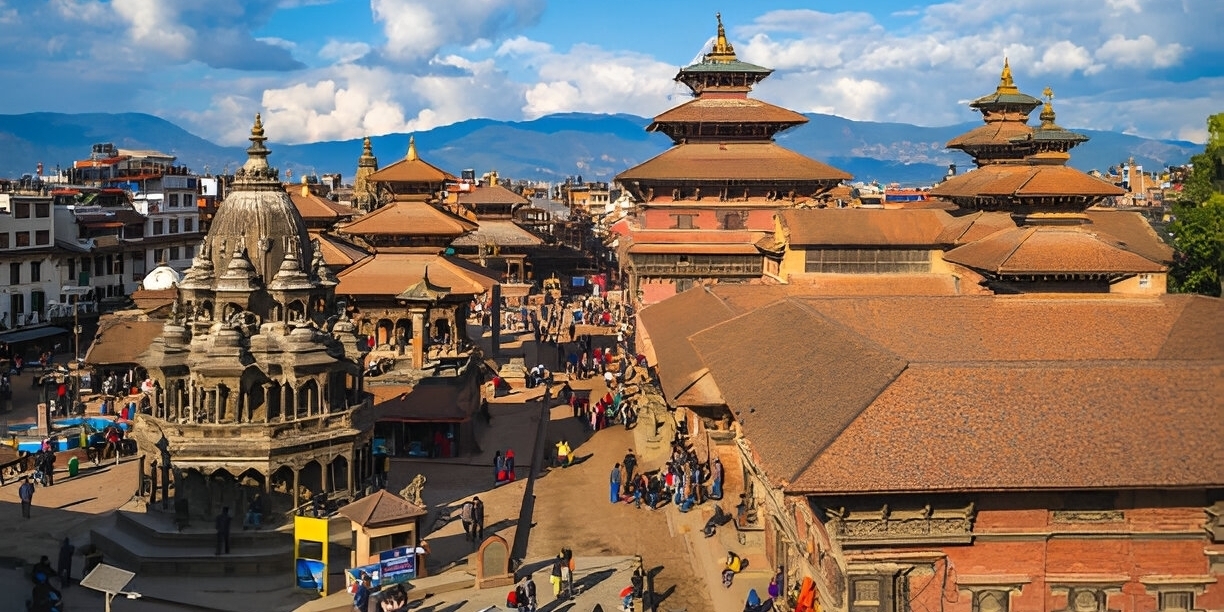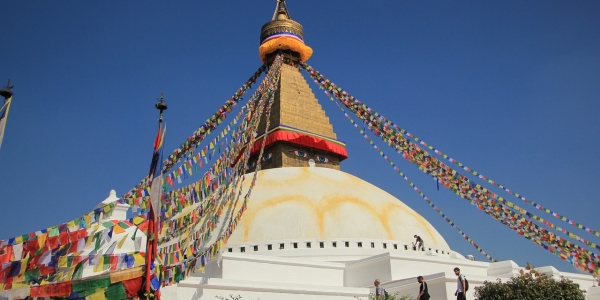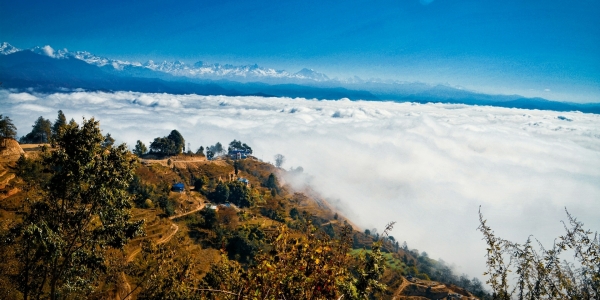Exploring the Beauty and Rich Heritage of Nepal
Nestled in the heart of the Himalayas, Nepal is a land of stunning natural beauty, rich cultural her...

Kathmandu, the vibrant capital of Nepal, is a city steeped in history and culture, making it a treasure trove of ancient landmarks and religious sites. Nestled in the Kathmandu Valley, this historical and cultural epicenter boasts a wealth of UNESCO World Heritage Sites and is rich in historical significance.
The Kathmandu Valley, which includes the cities of Kathmandu, Patan, and Bhaktapur, is renowned for its densely packed historical and cultural landmarks. This region has been a hub of trade, culture, and religion for centuries. Kathmandu itself, historically known as Kantipur, has played a crucial role as the political and economic heart of Nepal. Its strategic location along ancient trade routes connecting India and Tibet made it a melting pot of various cultures and influences.
The valley’s history dates back over 2,000 years, and it flourished under the rule of the Malla kings, who are credited with much of the architectural heritage that defines Kathmandu today. Their reign saw the construction of intricate temples, palaces, and public squares that continue to attract visitors from around the world.
Kathmandu Valley is home to seven UNESCO World Heritage Sites, each representing a unique aspect of its historical and cultural heritage:
Kathmandu Durbar Square
Historical Overview: Kathmandu Durbar Square, also known as Hanuman Dhoka Palace Square, is a historic plaza located in the heart of Kathmandu. The origins of Kathmandu Durbar Square can be traced back to the 3rd century AD during the Licchavi period. However, the square’s most prominent structures were constructed between the 12th and 18th centuries, primarily under the Malla kings who ruled the Kathmandu Valley during this period. The square was the political and cultural hub of the city, serving as the royal palace and the center for various state functions and ceremonies.
Architectural and Cultural Significance:
The square’s layout and architecture reflect the traditional Newar urban planning principles. The intricate woodwork, detailed carvings, and the ensemble of temples and palaces highlight the artistic achievements of the Malla period. Kathmandu Durbar Square was designated a UNESCO World Heritage Site in 1979 for its cultural and historical significance.
Why It Was Made:Kathmandu Durbar Square was primarily constructed to serve as the royal palace and the center for governance. It was also a religious and cultural center, hosting various festivals and rituals that were integral to the Malla rulers and their subjects.
Patan Durbar Square
Historical Overview: Patan Durbar Square, located in the city of Lalitpur (Patan), is another important historic site in the Kathmandu Valley. Patan is one of the three ancient cities in the valley and has a rich history dating back to the 3rd century AD. The square is renowned for its fine Newar architecture and was the royal palace complex of the Malla kings who ruled the region from the 12th to 18th centuries.
Architectural and Cultural Significance:
Patan Durbar Square is celebrated for its exquisite architecture, detailed wood carvings, and historical monuments. It was listed as a UNESCO World Heritage Site in 1979 due to its outstanding artistic and cultural significance.
Why It Was Made: The square served as the center of administration and royal residence during the Malla era. It was designed to reflect the grandeur and sophistication of the Malla kings and to host religious ceremonies and cultural festivities.
Bhaktapur Durbar Square
Historical Overview:Bhaktapur Durbar Square is situated in the ancient city of Bhaktapur, northeast of Kathmandu. It is one of the three royal squares in the Kathmandu Valley and has been an important center of culture and art since the Malla period. The square’s history dates back to the 12th century, and it was developed primarily during the reign of the Malla kings.
Architectural and Cultural Significance:
Bhaktapur Durbar Square is a prime example of Malla architecture, showcasing a blend of Hindu and Buddhist artistic traditions. The square’s buildings and monuments reflect the artistic and architectural innovations of the period. It was recognized as a UNESCO World Heritage Site in 1979.
Why It Was Made: The square functioned as the royal palace and administrative center of Bhaktapur. Its design and construction were intended to demonstrate the city’s artistic and architectural prowess and to serve as a venue for important state ceremonies and festivals.
Swayambhunath Stupa
Historical Overview:Swayambhunath Stupa, also known as the Monkey Temple, is located on a hilltop to the west of Kathmandu. The stupa’s origins are believed to date back to the 5th century AD, although some sources suggest earlier origins. The site has been a significant religious center for both Buddhists and Hindus for centuries.
Architectural and Cultural Significance:
Swayambhunath is an important pilgrimage site and a center of Tibetan Buddhism. The site’s unique blend of Buddhist and Hindu traditions, along with its panoramic views and rich history, make it a significant cultural landmark. It is also a UNESCO World Heritage Site.
Why It Was Made:Swayambhunath Stupa was constructed to serve as a major religious and pilgrimage site. Its elevated location and expansive stupa were intended to represent the spiritual center of the valley and to offer a place for meditation and worship.
Boudhanath Stupa
Historical Overview:Boudhanath Stupa is one of the largest and most significant stupas in Nepal, situated to the east of Kathmandu. The stupa’s construction is believed to have begun in the 5th century AD, with significant renovations occurring in the 14th century. It is a major center for Tibetan Buddhism.
Architectural and Cultural Significance:
Boudhanath Stupa is a focal point for Tibetan Buddhism in Nepal, and its grandeur and the surrounding monastic community make it a significant cultural and religious site. It was designated as a UNESCO World Heritage Site in 1979.
Why It Was Made: Boudhanath Stupa was constructed to serve as a major center for Buddhist worship and pilgrimage. Its size and elaborate design were intended to reflect the importance of the site as a spiritual hub for Buddhists in the region.
Pashupatinath Temple
Historical Overview:Pashupatinath Temple is one of the most sacred Hindu temples in Nepal, located on the banks of the Bagmati River just outside Kathmandu. The temple is dedicated to Lord Shiva and has a history that dates back to the 4th century AD, though it has undergone numerous renovations and expansions over the centuries.
Architectural and Cultural Significance:
Pashupatinath Temple is a crucial site for Hindu worship and pilgrimage, particularly during major festivals like Maha Shivaratri. It was inscribed as a UNESCO World Heritage Site in 1979 for its religious and cultural significance.
Why It Was Made:The temple was established as a major center of Hindu worship and rituals. Its location along the Bagmati River and its elaborate architecture were intended to reflect the spiritual significance of the site and to accommodate the extensive religious activities associated with Lord Shiva.
Changunarayan Temple
Historical Overview: Changunarayan Temple is located in the village of Changunarayan, on a hilltop east of Kathmandu. It is dedicated to Lord Vishnu and is considered one of the oldest Hindu temples in Nepal. The temple’s origins date back to the 3rd century AD, though it has been renovated and expanded over the centuries.
Architectural and Cultural Significance:
Changunarayan Temple is revered for its historical continuity and artistic achievements. It provides a glimpse into early Hindu temple architecture and is a testament to the region’s rich cultural heritage. It was designated as a UNESCO World Heritage Site in 1979.
Why It Was Made: The temple was built as a major center for the worship of Lord Vishnu and to serve as a site for religious ceremonies and rituals. Its design and location were intended to reflect the importance of Vishnu in Hinduism and to provide a focal point for local religious activities.
Rani Pokhari
Historical Overview:Rani Pokhari, also known as Queen’s Pond, is a historical water reservoir situated in the heart of Kathmandu, Nepal. The pond was constructed in the early 17th century, during the reign of King Pratap Malla, who ruled the Kathmandu Valley from 1641 to 1674. The construction of Rani Pokhari was completed in 1680.
Architectural and Cultural Significance:
Why It Was Made: Rani Pokhari was constructed as a royal pleasure garden and a reservoir for the use of the royal family. The pond served not only as a functional water source but also as a recreational and religious site. The construction of Rani Pokhari reflected the king’s desire to create a grand and serene space within the city, enhancing the aesthetic and cultural value of Kathmandu.
Tanta Ghar
Historical Overview:Tanta Ghar, also known as the Tanta House, is an important historical building located in Kathmandu. It is situated in the vicinity of the Kathmandu Durbar Square. The exact date of construction and the identity of the original builder are not well-documented, but the structure is believed to date back to the 16th century.
Architectural and Cultural Significance:
Why It Was Made: Tanta Ghar was constructed as a residential building for a prominent Newar family. The design and construction of the house reflect the architectural style and cultural values of the time. The building was intended to provide a spacious and aesthetically pleasing living environment for its inhabitants, showcasing the wealth and status of the family.
Both Rani Pokhari and Tanta Ghar are vital components of Kathmandu’s historical and cultural heritage. Rani Pokhari represents the grandeur of the Malla period and the royal aspirations of King Pratap Malla, while Tanta Ghar exemplifies the traditional Newar architectural style and the importance of preserving Kathmandu’s historical buildings.
Kathmandu is dotted with numerous other historical and cultural landmarks that offer a glimpse into its storied past:
Kathmandu's historical importance lies in its role as a major cultural and trade center in the Himalayas. Its strategic location along ancient trade routes facilitated the exchange of goods, ideas, and cultural influences between India, Tibet, and China. This rich history is reflected in the diverse architectural styles and religious sites scattered throughout the city.
Kathmandu is also famous for its unique blend of Hindu and Buddhist traditions, which are evident in its many temples and festivals. The city's historical significance is further underscored by its status as the ancient capital of the Malla Kingdoms, which contributed to its rich architectural and cultural heritage.
The old name of Kathmandu was "Kantipur," a term used during the Malla period. The city, historically known for its grandeur and strategic importance, was an important center of power and culture in ancient Nepal. The ancient city of Kathmandu, with its well-preserved palaces, temples, and squares, offers a fascinating glimpse into the past.
Beyond Kathmandu, Nepal is home to several other notable historical sites, including:
1. What is an interesting historic place in Nepal?
Nepal is home to many intriguing historic places, but one of the most captivating is the Kathmandu Durbar Square. This historic square is a stunning testament to Nepal's rich architectural and cultural heritage. It was once the royal palace complex of the Malla kings and is now renowned for its intricate pagoda-style temples, impressive courtyards, and detailed woodwork. Among its highlights are the Hanuman Dhoka Palace, the Taleju Temple, and the Kumari Ghar, which houses the living goddess or Kumari. The square offers a glimpse into Nepal’s regal past and its artistic traditions.
2. What is the historical importance of Kathmandu?
Kathmandu, the capital of Nepal, is historically significant as the cultural and political heart of the country. It has been a major hub for trade and cultural exchange between India and Tibet for centuries. The city was an important center of the Malla Kingdoms from the 12th to the 18th centuries, which influenced its architectural and cultural landscape. Kathmandu is home to Seven UNESCO World Heritage Sites, reflecting its historical, religious, and cultural importance. These sites include ancient temples, palaces, and stupas that showcase the city's rich history and artistic achievements.
3. Why is Kathmandu very famous?
Kathmandu is famous for its rich history, vibrant culture, and stunning architecture. It is known for its historic temples, stupas, and palaces that reflect a blend of Hindu and Buddhist traditions. The city is a melting pot of cultures, with festivals, traditional arts, and diverse cuisine. Additionally, Kathmandu serves as a gateway for trekkers and mountaineers heading to the Himalayas, including Mount Everest. The city's unique atmosphere, bustling markets, and spiritual heritage make it a popular destination for travelers from around the world.
4. Which is the oldest World Heritage Site in Nepal?
The oldest World Heritage Site in Nepal is the Swayambhunath Stupa, commonly known as the Monkey Temple. It is an ancient religious complex perched on a hilltop overlooking Kathmandu Valley. Believed to have been established over 2,000 years ago, it is one of the oldest and most revered Buddhist sites in Nepal. The stupa's iconic dome and spire, surrounded by numerous shrines and monasteries, make it a central place of worship and pilgrimage.
5. What are three places you can visit in Kathmandu?
In Kathmandu, three must-visit places include:
6. What are the three famous temples of Kathmandu?
Kathmandu is home to numerous famous temples, but three of the most renowned are:
7. Which is the beautiful place of Kathmandu?
One of the most beautiful places in Kathmandu is the Garden of Dreams. Located in the heart of the city, this serene and beautifully landscaped garden offers a peaceful escape from the hustle and bustle of urban life. Inspired by European gardens, it features elegant fountains, pristine lawns, and historic pavilions, making it a charming retreat for relaxation and reflection.
8. What is the old name of Kathmandu?
The old name of Kathmandu was Kantipur. This historical name reflects its status as a major city and trading hub in the ancient period. Kantipur was a key center of the Malla Kingdoms, and its name is often associated with its historical and cultural heritage.
9. What is unique about Kathmandu?
Kathmandu is unique for its rich tapestry of history, culture, and religion. It is a city where ancient temples and palaces coexist with vibrant street life and modern development. The city's unique architecture, including the intricately carved wooden buildings and pagoda-style temples, reflects its diverse cultural influences. Kathmandu’s role as a crossroads for trade and pilgrimage, along with its blend of Hindu and Buddhist traditions, contributes to its distinctive and multifaceted character.
10. What is the ancient city of Kathmandu?
The ancient city of Kathmandu refers to the historic core of the modern city, where much of the traditional architecture and cultural heritage are concentrated. This area includes the Kathmandu Durbar Square, which was the center of the ancient Malla Kingdoms and remains a key site for understanding the city's historical significance. The ancient city is characterized by its historic temples, palaces, and courtyards, offering a glimpse into Kathmandu's regal and spiritual past.
11. 10 historical places of Nepal
Ten notable historical places in Nepal include:
12. Most famous landmark in Nepal
One of the most famous landmarks in Nepal is the Swayambhunath Stupa. Known for its iconic stupa, panoramic views of Kathmandu, and its sacred status among Buddhists, it is a major cultural and spiritual symbol of Nepal. Its unique setting on a hilltop, combined with its rich history and religious significance, makes it a prominent landmark in the country.
Kathmandu's historical sites, with their intricate architecture and profound cultural significance, make it a fascinating destination for anyone interested in exploring the rich heritage of Nepal. Each site tells a story of the city’s past, contributing to its unique and enduring legacy.

Nestled in the heart of the Himalayas, Nepal is a land of stunning natural beauty, rich cultural her...


Kathmandu Valley is surrounded by an array of remarkable short hikes that provide not only stunning...
